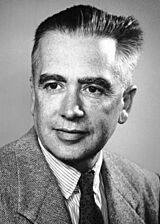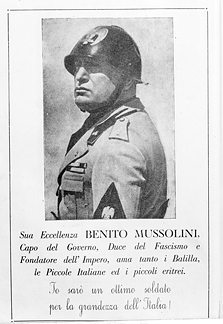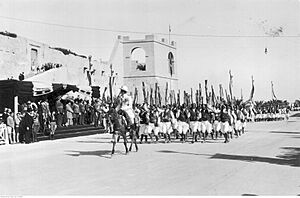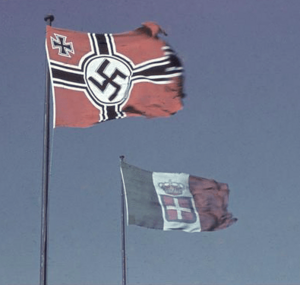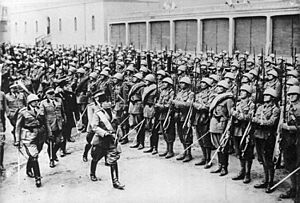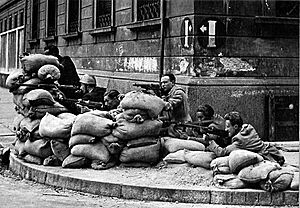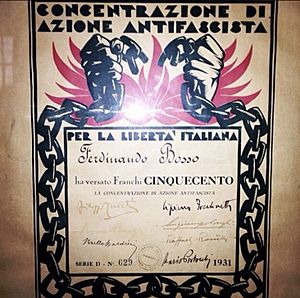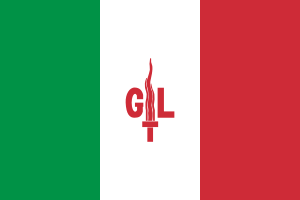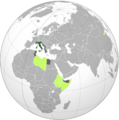Fascist Italy facts for kids
Quick facts for kids
Kingdom of Italy
Regno d'Italia (Italian)
|
|||||||||||
|---|---|---|---|---|---|---|---|---|---|---|---|
| 1922–1943 | |||||||||||
|
|
|||||||||||
|
Motto: FERT
(Motto for the House of Savoy) |
|||||||||||
|
Anthem:
(1861–1943) Marcia Reale d'Ordinanza ("Royal March of Ordinance") (1924–1943) Giovinezza ("Youth") |
|||||||||||
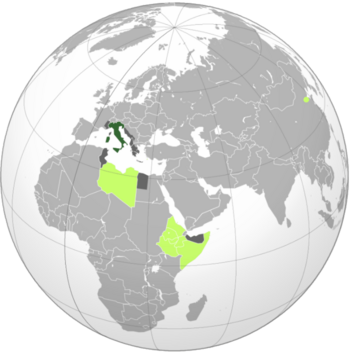
All territory ever controlled by Fascist Italy:
|
|||||||||||
| Capital and largest city
|
Rome | ||||||||||
| Common languages | Italian | ||||||||||
| Religion | Roman Catholicism | ||||||||||
| Demonym(s) | Italians | ||||||||||
| Government |
|
||||||||||
| King | |||||||||||
|
• 1900–1946
|
Victor Emmanuel III | ||||||||||
| Prime Minister and Duce | |||||||||||
|
• 1922–1943
|
Benito Mussolini | ||||||||||
|
• 1943
|
Pietro Badoglio | ||||||||||
| Legislature | Parliament | ||||||||||
| Senate | |||||||||||
| Chamber of Deputies (1922–1939) Chamber of Fasces and Corporations (1939–1943) |
|||||||||||
| History | |||||||||||
|
• March on Rome
|
31 October 1922 | ||||||||||
|
• Corfu incident
|
29 August 1923 | ||||||||||
| 11 February 1929 | |||||||||||
|
• Stresa Front
|
14 April 1935 | ||||||||||
| 1935–1936 | |||||||||||
|
• Intervention in Spain
|
1936–1939 | ||||||||||
| 7–12 April 1939 | |||||||||||
| 22 May 1939 | |||||||||||
|
• Entry into WWII
|
10 June 1940 | ||||||||||
| 27 September 1940 | |||||||||||
|
• Fall of Fascism
|
25 July 1943 | ||||||||||
| 3 September 1943 | |||||||||||
| Area | |||||||||||
| 1938 (including colonies) | 3,798,000 km2 (1,466,000 sq mi) | ||||||||||
| Population | |||||||||||
|
• 1936
|
42,993,602 | ||||||||||
| Currency | Lira (₤) | ||||||||||
|
|||||||||||
Fascist Italy describes the Kingdom of Italy when it was ruled by the National Fascist Party. This period lasted from 1922 to 1943. During this time, Benito Mussolini was both the prime minister and a powerful dictator. The Fascists took complete control, stopping all political opposition. They also worked to improve the economy, keep traditional social values, and make peace with the Roman Catholic Church.
The Fascist government went through different stages. At first (1922–1925), it seemed like a normal parliament, but Mussolini had a lot of power. He also ordered military actions in Italian colonies and annexed the city of Fiume. Later (1925–1929), the Fascist dictatorship truly began. From 1935 to 1940, Italy became more aggressive in its foreign policy. This included the Second Italo-Ethiopian War, which led to problems with the League of Nations. Italy also invaded Albania and signed the Pact of Steel with Germany.
From 1940 to 1943, Italy was part of World War II. It fought as a leading member of the Axis powers. After defeats in Africa and the Allied landings in Sicily, King Victor Emmanuel III removed and arrested Mussolini. The new government then signed a peace agreement with the Allies in September 1943. However, Nazi Germany took control of northern Italy. They rescued Mussolini and set up a new government called the Italian Social Republic (RSI). This was a puppet state controlled by Germany, with Mussolini still in charge.
After this, Italy entered a civil war. A large Italian resistance movement fought against the German and RSI forces. Mussolini was captured and killed in April 1945. The fighting ended the next day. After the war, Italians voted in 1946 to decide if Italy should remain a monarchy or become a republic. They chose to become the Italian Republic, which is the country we know today.
Contents
Life in Fascist Italy
After gaining power, the Fascist government aimed to make Italy a one-party state. They wanted Fascism to be part of every area of life. In 1935, they officially declared Italy a totalitarian state. This meant the government had complete control over everything.
Benito Mussolini and the Fascist government wanted to improve Italian culture and society. They looked back to ancient Rome for ideas. They also wanted to create a "new Italian man." This ideal person would put the state first and be ready to sacrifice for it. Only Fascists were seen as "true Italians." To get a good job, people often had to support the Fascist Party. The government also encouraged Italians living abroad to support Fascism.
Mussolini's propaganda made him seem like the country's hero. He was everywhere in Italian society. His popularity and strong speeches helped Fascism gain support. Huge rallies and parades of his Blackshirts in Rome inspired leaders like Adolf Hitler in Germany.
The Fascist government used newsreels, radio, and some films for propaganda. By 1926, all cinemas had to show propaganda newsreels before movies. These were very effective because few Italians had radios at the time. Fascist propaganda was also on posters and in state-supported art. However, artists and writers were not strictly controlled. They were only censored if they openly opposed the state. There was a strong focus on masculinity, showing aggression, youth, and sports. Women were expected to focus on being mothers and stay out of public life.
In 1929, a referendum was held instead of general elections. By then, the National Fascist Party (PNF) was the only legal party. Mussolini used this vote to confirm his single-party rule. About 98% of voters approved the Fascist list. Voting rights were limited to men who were part of a trade union, soldiers, or clergy members. This meant only about 9.5 million people could vote.
The Catholic Church in Italy
Relations between Italy and the Roman Catholic Church improved greatly under Mussolini. In 1870, the new Kingdom of Italy had taken over the remaining Papal States. This meant the Pope lost his political power.
In 1929, Mussolini and the papacy (the Pope's government) signed the Lateran Accord. This agreement ended a long disagreement. The treaty recognized the Pope as the head of Vatican City, a new tiny state within Rome. This made the Vatican an independent place for world diplomacy. The agreement also made Roman Catholicism the official religion of Italy. It paid salaries to priests, recognized religious marriages, and brought religious lessons into public schools. In return, bishops promised loyalty to the Fascist government. The Vatican also received money for Church property taken since 1860.
The Church was not forced to support the Fascist government, and some differences remained. However, the strong hostility between them ended. The Church supported some of Italy's foreign policies, like helping Nationalists in the Spanish Civil War. It also supported the invasion of Ethiopia. There was some tension over the Catholic youth group, Azione Cattolica. Mussolini wanted to combine it with his Fascist youth group. In 1931, Pope Pius XI spoke out against the government's actions against the Church.
In 1938, the Fascist government introduced Italian Racial Laws. These laws were made to harm and persecute Italian Jews and Protestant Christians. However, the Vatican often spoke out against these laws.
Despite Italy's close ties with Hitler's Germany, Italy did not fully adopt the Nazi idea of harming Jews. Nazi Germany was frustrated because Italian authorities did not help round up Jews. No Jews were sent to concentration camps from Italy before 1943. After Mussolini was removed in July 1943, the Germans occupied Italy. They then began rounding up Jews. Thousands of Italian Jews and some Protestants died in Nazi concentration camps.
Antisemitism in Italy
A main difference between Nazi Germany and Fascist Italy was their view on Jews. Before his alliance with Adolf Hitler, Benito Mussolini said there was no antisemitism in his party. In the early 1920s, he wrote that Italy would never have a "Jewish Question". He hoped Italian Jews would not cause antisemitism in the country. In 1932, Mussolini called antisemitism a "German vice." He first rejected Nazi racism, but later changed his stance for political reasons.
In 1938, under pressure from Germany, Mussolini ordered an antisemitic policy. This policy was very unpopular in Italy, even within the Fascist Party itself.
Education and Learning
The Fascist government wanted to improve education in Italy. They aimed to end illiteracy, which was a big problem. They also wanted to make Italians more loyal to the state. To stop students from dropping out, they made the school leaving age 14. They also made sure students attended school.
The first education minister, Giovanni Gentile, wanted education to teach students about Fascism. He wanted youth to respect and obey authority. By 1929, education was fully focused on teaching Fascist ideas. The government controlled all textbooks. All high school teachers had to promise loyalty to Fascism. Children were taught to be as loyal to Fascism as they were to God. By 1933, all university teachers had to be members of the Fascist Party.
From the 1930s to 1940s, Italian history lessons focused on Rome's past as a great civilization. They also highlighted Italian nationalism and the fight for independence. In the late 1930s, Italy copied Germany's focus on physical fitness. They wanted all Italians to be physically healthy.
The Fascist government also supported smart people. They created the Royal Academy of Italy in 1926. This group helped promote and organize intellectual activities in Italy.
Social Programs
A big success in Fascist Italy was the Opera Nazionale Dopolavoro (OND). This "National After-work Program" started in 1925. The OND was the largest recreation group for adults. By the 1930s, every town had an OND clubhouse. The OND created 11,000 sports fields, over 6,400 libraries, and many movie theaters and orchestras. Joining was voluntary and not political. By 1936, about 80% of paid workers were part of the OND. Many workers enjoyed the sports activities. The OND was the most popular Fascist organization. Its success even led Nazi Germany to create its own similar program.
Another popular group was the Opera Nazionale Balilla (ONB). It gave young people access to clubs, dances, sports, and concerts for free or very low cost. It also organized sports events.
Between 1928 and 1930, the government started offering pensions (money for retirement), sick pay, and paid holidays. In 1933, they added unemployment benefits. By the late 1930s, 13 million Italians had state health insurance. By 1939, social security spending was 21% of government money. In 1935, the 40-hour working week was introduced. Workers were expected to spend Saturday afternoons on sports, military training, or political activities. This was called Sabato fascista ("Fascist Saturday"). However, most Italians preferred to rest on Saturdays, so this plan did not fully succeed.
Police and Military

To keep control, Mussolini created the Milizia Volontaria per la Sicurezza Nazionale in 1923. These were known as "Blackshirts" because of their uniforms. Most Blackshirts were members of Mussolini's early Fascist groups. A secret police force called OVRA was formed in 1927. It was led by Arturo Bocchini and aimed to stop anyone who opposed the government. While OVRA caused fewer deaths than similar groups in Germany or the Soviet Union, it was effective at scaring political opponents.
The Fascist government also tried to fight organized crime, like the Cosa Nostra in Sicilia. In 1925, they gave special powers to Cesare Mori, a police chief in Palermo. He was able to arrest many Mafiosi, forcing some to flee abroad. However, Mori was later removed when he started looking into Mafia links within the Fascist government. The Fascist government then claimed the Mafia threat was gone. Mori's actions weakened the Mafia, but did not destroy it. From 1929 to 1943, the Fascist government stopped its strong actions against the Mafia.
Women's Roles
The Fascists paid close attention to the role of women. They wanted to "save" women from becoming too independent. At the same time, they talked about a "new Italian woman" (nuova italiana). This showed a conflict between modern ideas and traditional male authority. Catholic, Fascist, and business ideas all tried to shape how women saw their roles.
When Italy invaded Ethiopia in 1935, women's roles in the Fascist Party changed. The idea of empire and women's part in it became a key message in Fascist propaganda. Women in the party were asked to help the empire by producing goods and consuming them. This gave them a new importance in the country. Fascist women's groups taught women how to avoid waste in housework. Young Italian women were also trained to be colonial wives.
The government tried to achieve "food independence." This meant Italy would produce all its own food. This policy was controversial because Italians cared a lot about their food. The goal was to reduce imports and support Italian farming. They encouraged a simple diet of bread, polenta, pasta, fresh produce, and wine. Fascist women's groups taught "autarkic cookery" to use local foods. Food prices went up in the 1930s. People were told to eat less dairy and meat. More Italians started buying food on the black market. This showed that Fascists saw food, and people's behavior, as resources they could control.
Economy in Fascist Italy
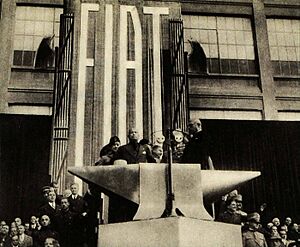
Mussolini and the Fascist Party promised a new economic system called corporatism. This system would organize workers and employers into groups called professional corporations. In 1935, the Doctrine of Fascism explained the state's role in this economy. It said that private businesses were best for the nation. The government would only step in if private efforts were not enough, or if state interests were involved.
Fascists claimed this system would be fair and traditional. However, corporatism quickly failed. Business owners and landowners, who supported the Fascist Party to stop socialism, opposed the left-wing ideas of Fascism. So, the policy became controlled by industries. At first, economic laws helped rich businesses and farmers. They allowed private ownership, tax cuts, and other reforms. But after a political crisis, Mussolini pushed for a totalitarian state. In 1926, laws were passed that organized the economy into twelve employer and employee unions. These unions were mostly controlled by the state. They were used to stop opposition and reward loyalty. While these unions could not protect workers from all economic problems, they did handle social security and severance pay. They could also sometimes negotiate contracts that helped workers.
After the Great Depression hit in 1929, the Fascist government used tariffs to protect its economy. They also tried to guide the economy. In the 1930s, Italy grew more wheat and became self-sufficient in wheat. This stopped wheat imports from other countries. However, growing more wheat meant less land for vegetables and fruit. Also, the lives of farmers did not improve. A small number of wealthy people owned most of the farmland. Farmers' incomes did not increase, but taxes did. The Depression caused unemployment to rise from 300,000 to 1 million by 1933. Real income dropped by 10%, and exports fell. Still, Italy did better than most Western countries during the Depression. Its social programs helped lessen the impact. Italy's industrial growth from 1913 to 1938 was even better than Germany's. Only the United Kingdom and Scandinavian countries had higher industrial growth.
Italy's expansion into Ethiopia in 1936 hurt its economy. The cost of running the colony of Italian East Africa in 1936–1937 was more than Italy's total income for that year.
Technology and Modernization
In 1933, Italy achieved many technological successes. The Fascist government spent a lot of money on projects. They built the Italian ocean liner SS Rex, which crossed the Atlantic in a record four days in 1933. They also funded the Macchi M.C.72 seaplane, which became the world's fastest seaplane in 1933 and 1934. In 1933, Fascist leader and aviator Italo Balbo flew a flying boat across the Atlantic to Chicago for the Century of Progress World's Fair.
Foreign Policy and Empire Building
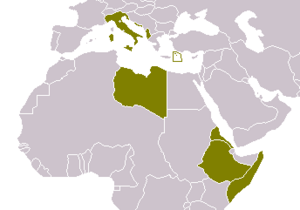
Mussolini wanted to make Italy a "Great Power" in Europe again. He promised to create a "New Roman Empire." He said Italy would control the Mediterranean Sea. Fascist propaganda used the old Roman term "Mare Nostrum" (Latin for "Our Sea") for the Mediterranean. The government spent more money on military projects. They planned to build an Italian Empire in Northern and Eastern Africa. They also wanted to regain control in the Mediterranean and Adriatic Sea. The Fascists started wars to conquer areas like Dalmazia, Albania, and Greece for their empire.
Actions in Africa
Italy's colonial efforts in Africa began in the 1920s. There was a civil war in Italian North Africa because the Arab people did not accept Italian rule. Mussolini sent Marshal Rodolfo Graziani to fight the Arab nationalists. Omar Mukhtar led the Arab resistance. After 1928, Fascist policy in Libya became very harsh. A barbed wire fence was built to cut off supplies to the resistance. The government also forced over 100,000 people from Jebel Akhdar into concentration camps. Tens of thousands died there from bad conditions. It is thought that at least 80,000 Libyans died. After Al-Mukhtar was captured and executed in 1931, the resistance ended.
Italy also negotiated with Britain to expand its colony of Libya. In 1925, they defined the border with British-held Egypt, giving Italy new territory. In 1934, Italy gained more land for Libya from British-held Sudan.
In 1935, Mussolini decided it was time to invade Ethiopia. This led to the Second Italo-Abyssinian War. Italy invaded from its colonies of Eritrea and Somaliland. Italy used poison gas against Ethiopian soldiers during the war. Ethiopia surrendered in 1936. This was Italy's revenge for a failed conquest in the 1890s. King Victor Emmanuel III was then called Emperor of Ethiopia. Other countries condemned Italy's actions. France and Britain lost trust in Mussolini. The League of Nations officially condemned Italy, so Mussolini pulled Italy out of the League in 1937.
Actions in Europe
The Fascist government also took strong actions in Europe. In 1923, Italian soldiers took the Greek island of Corfu. This was part of a plan to take over Greece. Corfu was later returned, and war was avoided. In 1925, Italy made Albania a protectorate, which helped Italy against Greece. Corfu was important to Italy because of its history with the old Republic of Venice.
Relations with France were complicated. The Fascist government wanted to fight France to get back Italian-speaking areas. But when Hitler rose to power, Italy worried about Austria's independence and Germany's threat. Because of this, Italy joined the Stresa Front with France and Britain against Germany from 1935 to 1936.
The Fascist government had bad relations with Yugoslavia. They wanted Yugoslavia to break apart so Italy could expand. Italy spied in Yugoslavia, and spy rings were found in the Italian Embassy. In 1929, the Fascist government welcomed Croatian nationalist Ante Pavelić to Italy. They gave him money and a training ground for his Fascist group, the Ustaše. This group later caused great harm to many people during World War II.
After Germany took over Czechoslovakia, Mussolini focused on Albania. On April 7, 1939, Italy invaded Albania. After a short fight, Albania was occupied and became an Italian protectorate. King Victor Emmanuel III was crowned King of Albania. Italy justified this by saying Albania was part of the ancient Roman Empire. However, by then, Albania had little connection to Italy. Albania was already very close to Italy before the invasion. Italy had gained a lot of influence over Albania's economy and army through earlier treaties. King Emmanuel III was not happy about the occupation. He feared it made Italy even more isolated.
Involvement in Spain
In 1936, Italy made its biggest military move before World War II. Spain was in a Spanish Civil War between socialist Republicans and nationalists led by Francisco Franco. Italy sent planes, weapons, and over 60,000 troops to help the Spanish nationalists. This war helped train the Italian military. It also improved relations with the Roman Catholic Church. Italy's success in Spain helped it control access to the Atlantic Ocean from the Mediterranean Sea. Germany also helped in the Spanish Civil War. This was the first time Italian and German forces fought together since the 1870s. In the 1930s, Italy built many large warships to strengthen its control over the Mediterranean Sea.
Relations with Germany
When the Nazi Party came to power in Germany in 1933, Mussolini publicly approved. He said, "The victory of Hitler is our victory." The Fascist government also talked about forming an alliance with Germany. However, in private, Mussolini and the Fascists did not approve of the Nazi government. Mussolini did not like Hitler, even though they had similar ideas. The Fascists worried about Hitler's ideas of a "Greater Germany." They feared Germany might want Italian territories that were once part of the Austrian Empire.
Hitler admired Mussolini and copied many Fascist symbols. These included the Roman salute, dramatic speeches, uniformed groups for political violence, and large rallies. In 1922, Hitler even asked Mussolini for advice on how to organize his own "March on Berlin." Mussolini did not respond because he thought Hitler was a bit strange. Mussolini tried to read Mein Kampf to understand Hitler's movement. But he found it "a boring book that I have never been able to read." He said Hitler's ideas were "little more than common sayings." While Mussolini, like Hitler, believed white people were superior, he was against Hitler's antisemitism. Mussolini believed culture, not race, was the key to superiority.
Hitler continued to try to win over Mussolini. Eventually, Mussolini gave money to the Nazi Party. He also allowed Nazi groups to train in Italy. He believed a nationalist government in Germany could help Italy. After 1933, Italy became more suspicious of Germany. Mussolini wanted to make sure Germany did not become the most powerful nationalist state in Europe. To do this, he opposed Germany's efforts to take over Austria in 1934. He promised Austria military support if Germany interfered. This promise helped save Austria from being taken over in 1934.

Publicly, propaganda showed Mussolini and Hitler as close allies. It also showed how similar Italian Fascism and German Nazism were. But both leaders were suspicious of each other and competed for influence. Hitler and Mussolini first met in June 1934. After this meeting, Mussolini privately called Hitler "a silly little monkey."
After Italy became isolated in 1936, it had to work with Germany to regain influence. Italy reluctantly stopped supporting Austria's independence. In September 1937, Mussolini visited Germany to build closer ties. In October 1937, Mussolini said Italy supported Germany getting back its colonies lost in World War I.
With no strong opposition from Italy, Hitler took over Austria in 1938. Germany then claimed the Sudetenland in Czechoslovakia. Mussolini felt he had to help Germany to avoid being isolated. After Austria was taken by Germany, the Fascist government worried about the German population in South Tyrol. They wondered if these Germans would want to join Germany. The Fascists also wondered if Italy should follow Nazi antisemitic policies to please Germany. In 1938, Mussolini pushed for antisemitic policies, but many Fascists were Jewish, and antisemitism was not common in Italy. Still, Mussolini forced these laws through. In return, Mussolini demanded a favor from Hitler. In 1939, Italy asked Hitler to agree that all Germans in South Tyrol must either leave Italy or become Italian. Hitler agreed, which removed the threat from the South Tyrol Germans.
Alliance and World War II
As war approached in 1939, the Fascist government started a strong campaign against France. They claimed Italians in France were suffering. This was important for the alliance because both Germany and Italy wanted parts of France. In May 1939, they formed a formal alliance called the Pact of Steel. This pact forced Italy to fight alongside Germany if war broke out. Mussolini felt he had to sign it, even though he worried Italy was not ready for war. He wanted to build an empire and did not want Hitler to become the only powerful leader in Europe. Mussolini was unhappy when Germany invaded Poland, but he remained silent.

Italy's military was already busy from earlier wars in Spain, Ethiopia, Libya, and Albania. It was not ready for a long war. But Mussolini joined the war to expand the Fascist empire. He wanted to bring back the Roman Empire in the Mediterranean.
Italy joined World War II as one of the Axis Powers in 1940. It entered after France seemed likely to lose to Germany. The Italian invasion of France was short, as France surrendered soon after. Italy prepared to fight the British Empire in Africa and the Middle East. This was called the "parallel war." Italy had some early success, bombing Palestine and invading Egypt and British Somaliland. However, the Italian military showed weakness during the 1940 Greco-Italian War. Germany had to help Italy during the Battle of Greece. By late 1942, Italy had expanded its influence across the Mediterranean. Most of Greece was occupied by Italy. Italians also controlled parts of French territories like Corsica and Tunisia. A puppet government was set up in Croatia after the German-Italian Invasion of Yugoslavia. Albania, Ljubljana, coastal Dalmatia, and Montenegro were directly taken by Italy. Italian and German forces also won battles against rebels in Yugoslavia and occupied parts of British-held Egypt.
However, Italy's conquests were always challenged. There were many rebel groups, especially the Greek resistance and Yugoslav partisans. Allied forces also fought Italy in the Battle of the Mediterranean. In 1941, Germany and Japan's actions brought the Soviet Union and United States into the war. This ruined Italy's plan to make Britain agree to peace. The Italian Empire eventually collapsed after big defeats in Eastern Europe and North Africa. In July 1943, after the Allied invasion of Sicily, Mussolini was arrested by King Victor Emmanuel III. This started the Italian Civil War. Italy's military outside the country fell apart, and its occupied lands came under German control. Italy surrendered to the Allies on September 3, 1943.
The northern part of Italy was occupied by the Germans. Italian Fascists worked with them to create the Italian Social Republic. This was a puppet state still led by Benito Mussolini. It recruited over 500,000 soldiers for the Axis. The southern part of Italy was controlled by the king's forces. They fought for the Allies as the Italian Co-Belligerent Army. There were also about 350,000 Italian resistance movement fighters, many of them former soldiers. They fought against German and Fascist forces across Italy. On April 28, 1945, Benito Mussolini was executed by Italian resistance fighters. This was two days before Adolf Hitler's suicide.
Anti-Fascism: Opposing Mussolini's Rule

In Italy, Mussolini's Fascist government called its opponents "anti-fascists." Mussolini's secret police was called the "Organization for Vigilance and Repression of Anti-Fascism." In the 1920s, anti-fascists, many of whom were workers, fought against the violent Blackshirts and Mussolini's rise to power.
After the main Socialist Party signed a peace agreement with Mussolini in 1921, some workers disagreed. They formed a group called Arditi del Popolo. However, the main labor union and Socialist Party did not officially recognize this group. They wanted to use peaceful, legal methods. The Communist Party also told its members to leave the Arditi del Popolo.
The Italian liberal anti-fascist Benedetto Croce wrote his Manifesto of the Anti-Fascist Intellectuals in 1925. Other important liberal anti-fascists were Piero Gobetti and Carlo Rosselli.
The Concentrazione Antifascista Italiana (Italian Anti-Fascist Concentration) was a group of anti-fascist organizations. It existed from 1927 to 1934. It was founded in France by Italians who had left Italy. This group brought together non-communist anti-fascist forces. They wanted to fight fascism in Italy. They published a newspaper called La Libertà.
Giustizia e Libertà (Justice and Freedom) was an Italian anti-fascist resistance movement. It was active from 1929 to 1945. Carlo Rosselli, Ferruccio Parri (who later became Prime Minister), and Sandro Pertini (who became President) were among its leaders. Members had different political ideas but all believed in actively fighting fascism. This group also told the world about the truth of fascism in Italy.
Many Italian anti-fascists fought in the Spanish Civil War. They hoped to show how to resist dictatorships, like Franco's in Spain and Mussolini's in Italy. Their motto was: "Today in Spain, tomorrow in Italy."
Between 1920 and 1943, several anti-fascist groups were active among Slovenes and Croats. These were in areas Italy had taken after World War I. The most important was the group TIGR. They carried out many acts of sabotage and attacked Fascist officials. Most of TIGR's secret network was found by the OVRA secret police in 1940 and 1941. After June 1941, many of its members joined the Slovene Partisans.
During World War II, many members of the Italian resistance left their homes. They went to live in the mountains and fought against Italian Fascists and German Nazi soldiers. Many Italian cities, like Turin, Naples, and Milan, were freed by anti-fascist uprisings.
Images for kids
See also
 In Spanish: Italia fascista para niños
In Spanish: Italia fascista para niños
- Italian Fascism
- Mussolini Cabinet
- European interwar dictatorships
- Fascism in Europe






